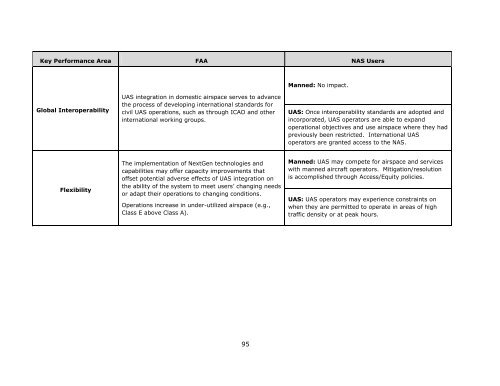FAA-UAS-Conops-Version-2-0-1
FAA-UAS-Conops-Version-2-0-1
FAA-UAS-Conops-Version-2-0-1
You also want an ePaper? Increase the reach of your titles
YUMPU automatically turns print PDFs into web optimized ePapers that Google loves.
Key Performance Area <strong>FAA</strong> NAS Users<br />
Global Interoperability<br />
Flexibility<br />
<strong>UAS</strong> integration in domestic airspace serves to advance<br />
the process of developing international standards for<br />
civil <strong>UAS</strong> operations, such as through ICAO and other<br />
international working groups.<br />
The implementation of NextGen technologies and<br />
capabilities may offer capacity improvements that<br />
offset potential adverse effects of <strong>UAS</strong> integration on<br />
the ability of the system to meet users’ changing needs<br />
or adapt their operations to changing conditions.<br />
Operations increase in under-utilized airspace (e.g.,<br />
Class E above Class A).<br />
95<br />
Manned: No impact.<br />
<strong>UAS</strong>: Once interoperability standards are adopted and<br />
incorporated, <strong>UAS</strong> operators are able to expand<br />
operational objectives and use airspace where they had<br />
previously been restricted. International <strong>UAS</strong><br />
operators are granted access to the NAS.<br />
Manned: <strong>UAS</strong> may compete for airspace and services<br />
with manned aircraft operators. Mitigation/resolution<br />
is accomplished through Access/Equity policies.<br />
<strong>UAS</strong>: <strong>UAS</strong> operators may experience constraints on<br />
when they are permitted to operate in areas of high<br />
traffic density or at peak hours.


